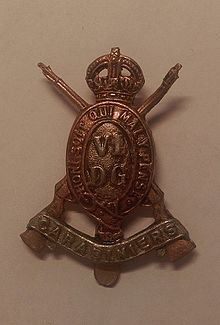
The Royal Scots Greys was a cavalry regiment of the British Army from 1707 until 1971, when they amalgamated with the 3rd Carabiniers to form the Royal Scots Dragoon Guards.

The Royal Scots Dragoon Guards (Carabiniers and Greys) is a cavalry regiment of the British Army, and the senior Scottish regiment. The regiment, through the Royal Scots Greys, is the oldest surviving Cavalry Regiment of the Line in the British Army. The regiment is based at Waterloo Lines, Leuchars Station, as part of 51st Infantry Brigade and Headquarters Scotland, a light adaptable force brigade.
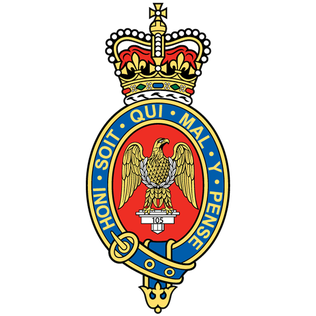
The Blues and Royals (RHG/D) is a cavalry regiment of the British Army, part of the Household Cavalry. The Colonel of the Regiment is Anne, Princess Royal. It is the second-most senior regiment in the British Army.

A carabinier is in principle a soldier armed with a carbine, musket, or rifle, which became commonplace by the beginning of the Napoleonic Wars in Europe. The word is derived from the identical French word carabinier.

The 5th Royal Irish Lancers was a cavalry regiment of the British Army. It saw service for three centuries, including the First World War. It amalgamated with the 16th The Queen's Lancers to become the 16th/5th Lancers in 1922.

The Royal Dragoon Guards (RDG) is a cavalry regiment of the British Army. It was formed in 1992 by the amalgamation of two other regiments: The 4th/7th Royal Dragoon Guards and the 5th Royal Inniskilling Dragoon Guards. Based in Battlesbury Barracks, Wiltshire, the regiment currently serves as the armoured cavalry reconnaissance unit of 20th Armoured Brigade Combat Team. Previously equipped with the Scimitar armoured reconnaissance vehicle, it started converting to the Warrior tracked armoured vehicle in 2022.
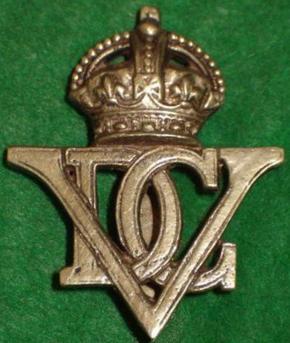
The 5th Royal Inniskilling Dragoon Guards was a cavalry regiment of the British Army formed in 1922 by the amalgamation of the 5th Dragoon Guards and the 6th (Inniskilling) Dragoons. It served in the Second World War and the Korean War. In August 1992, as a consequence of the Options for Change defence cuts, the regiment was amalgamated with the 4th/7th Royal Dragoon Guards to form the Royal Dragoon Guards.

The 3rd Carabiniers (Prince of Wales's Dragoon Guards) was a cavalry regiment of the British Army. It was formed in 1922 as part of a reduction in the army's cavalry by the amalgamation of the 3rd Dragoon Guards (Prince of Wales's) and the Carabiniers (6th Dragoon Guards), to form the 3rd/6th Dragoon Guards. It was renamed the 3rd Carabiniers (Prince of Wales's Dragoon Guards) in 1928 and amalgamated with the Royal Scots Greys (2nd Dragoons), forming the Royal Scots Dragoon Guards (Carabiniers and Greys) in 1971.

The 1st King's Dragoon Guards was a cavalry regiment in the British Army. The regiment was raised by Sir John Lanier in 1685 as the 2nd Queen's Regiment of Horse, named in honour of Queen Mary, consort of King James II. It was renamed the 2nd King's Own Regiment of Horse in 1714 in honour of George I. The regiment attained the title 1st King's Dragoon Guards in 1751. The regiment served as horse cavalry until 1937 when it was mechanised with light tanks. The regiment became part of the Royal Armoured Corps in 1939. After service in the First World War and the Second World War, the regiment amalgamated with the 2nd Dragoon Guards in 1959 to form the 1st The Queen's Dragoon Guards.

The 4th Royal Irish Dragoon Guards was a cavalry regiment in the British Army, first raised in 1685 as the Earl of Arran's Regiment of Cuirassiers. It was renamed as the 4th Dragoon Guards in 1788 and service for two centuries, including the First World War, before being amalgamated with 7th Dragoon Guards, to form the 4th/7th Dragoon Guards in 1922.
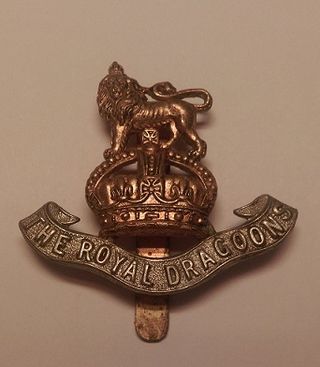
The Royal Dragoons was a heavy cavalry regiment of the British Army. The regiment was formed in 1661 as the Tangier Horse. It served for three centuries and was in action during the First and the Second World Wars. It was amalgamated with the Royal Horse Guards to form The Blues and Royals in 1969.

Lieutenant General Sir Charles James Briggs, was a British Army officer who held high command in World War I.

The 2nd Dragoon Guards (Queen's Bays) was a cavalry regiment of the British Army. It was first raised in 1685 by the Earl of Peterborough as the Earl of Peterborough's Regiment of Horse by merging four existing troops of horse.

The 3rd Dragoon Guards was a cavalry regiment in the British Army, first raised in 1685 as the Earl of Plymouth's Regiment of Horse. It was renamed as the 3rd Regiment of Dragoon Guards in 1751 and the 3rd Dragoon Guards in 1765. It saw service for two centuries, including the First World War, before being amalgamated into the 3rd/6th Dragoon Guards in 1922.

The 5th Dragoon Guards was a British army cavalry regiment, officially raised in January 1686 as Shrewsbury's Regiment of Horse or the Earl of Shrewsbury's Horse.

The 4th Queen's Own Hussars was a cavalry regiment in the British Army, first raised in 1685. It saw service for three centuries, including the First World War and the Second World War. It amalgamated with the 8th King's Royal Irish Hussars, to form the Queen's Royal Irish Hussars in 1958.
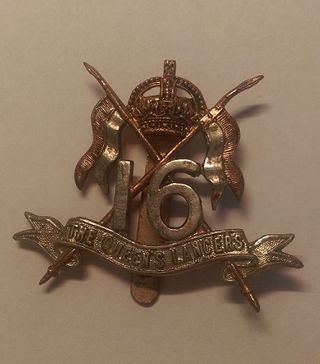
The 16th The Queen's Lancers was a cavalry regiment of the British Army, first raised in 1759. It saw service for two centuries, before being amalgamated with the 5th Royal Irish Lancers to form the 16th/5th Lancers in 1922.

The 15th The King's Hussars was a cavalry regiment in the British Army. First raised in 1759, it saw service over two centuries, including the First World War, before being amalgamated with the 19th Royal Hussars into the 15th/19th The King's Royal Hussars in 1922.
The First World War British Cavalry Corps was formed 9 October 1914.
Major-General Henry Peregrine Leader, was a major-general in the British Army. He served in the Second Boer War, the First World War and the Third Afghan War. He rose in rank to command his regiment the 6th Dragoon Guards, two cavalry brigades and a cavalry division, for which he was invested with the Order of the Bath.
